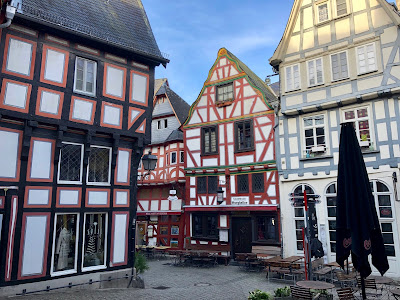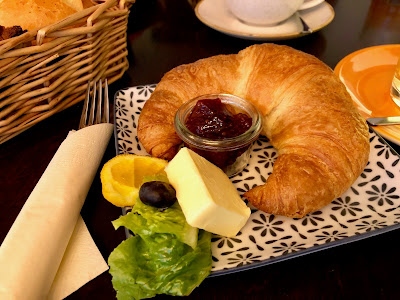Limburg
Recently we drove to Limburg, a cathedral town along the river Lahn. The old town was adorable with lovely half-timbered houses and narrow cobbled streets. It's always nice to take a stroll in the early morning without bumping with other visitors.
The uphill path led us to the former Bishop's house and chapel, a part of which is now a museum that presents the almost two hundred year history of the diocese. We were too early to see the museum.
The path continued to the Limburg Cathedral, or Limburger Dom in German. The centerpiece of the old town!
The construction of the cathedral was built in the late 12th century in four stages at the site of the 9th century castle/church complex. It was in a late Romanesque style with some Gothic addition. However, it changed into a late Baroque style during the 18th century restoration of the damages due to the 17th century wars. The restoration replaced or covered up so many parts of the original. The 19th century's Romantic period helped the cathedral being back to the original style and the work continued in the 20th century. That's why the cathedral somewhat looked like a result of patchworks.
There were some interesting medieval frescoes inside, which had been hidden under the Baroque interior until the later renovation unveiled and repainted. Good job!
The front of the cathedral was pretty much two-dimensional but the back was 3D. The image of the cathedral was printed on the 1,000-mark note, which was in circulation from 1960 to 1989. It was portrayed from an oblique angle that showed both the front and back. I found the image on the note. The cathedral looked magnificent!
There was Schloss Limburg next to the cathedral. It was a part of the 9th century castle/church complex like the cathedral. It served as the residence of the regional nobles including the Lords of Limburg during medieval times. Today it belongs to the city of Limburg and is partially used as the municipal archive. Still you can walk through the courtyard and see the exterior of the castle as we did.
We walked down and looked for a place for breakfast. Our choice was Café Kolorit.
Unfortunately they didn't serve any hot meals but a typical German style breakfast - bread/rolls with butter and jam, cold cut meat, cheese, and a boiled egg, which J had along with freshly squeezed grapefruit juice and cappuccino with oat milk, or a croissant with butter and jam, which I ordered along with green tea. I heard that German often eats bread/rolls without toasting them. I started believing that statement. Perhaps bread is so important to German and bakeries are everywhere. People buy fresh bread everyday and don't have to heat them up to refresh?? Anyway, my croissant was fine and the cafe was cozy.
After the breakfast, we walked more in the old town. It was pretty small and we quickly covered almost all. Then we decided to go to the old bridge and see the town over the river.
It's fun to find mysterious curved decorations on the exterior of half-timbered houses.
Unexpectedly the bridge was under construction! At least the pedestrian path on one side was available. We walked to the bridge tower on the opposite side and immediately returned to the old town since there seemed to be nothing to particularly see on the side.
Coming to the bridge wasn't totally waste of time, though. We took some nice photos of the cathedral from the bridge! The view from this angle was actually very close to the image on the banknote that I mentioned above.
The main purpose to visit Limburg was actually to get baumkuchen, a traditional German cake. When I found out that there is a bakery/cafe that makes baumkuchen by themselves in the old town, Limburg joined my go-to list. Baumkuchen is one of my favorite cakes. I see some in grocery stores and in bakeries in Wiesbaden, but haven't seen freshly baked one yet.
The bakery/cafe is called Café Kosmol. The red half-timbered house that a big red parasol was in front of.
Once we entered the shop, a traditional baumkucken baking equipment welcomed us! However, we were told that baumkuchen was sold out and it would be back in four days (something like that in German). I was so disappointed... On the other hand, J picked up a couple of baked goods at the shop, which cheered me up.
Plus, we stopped by at another bakery/cafe, Café Will and bought two kinds of pasties. That made me happier!
We tasted those from Café Will with tea when we got home. One was called Limburger Säcker. The pastry was delightful. The chunky apple compote hidden under the crumbles was a surprise! According to the cafe, it's their original pastry. Based on a traditional family recipe from the 18th century and now in the 5th generation, the baker carefully hand-makes Limburger Säcker with fine ingredients including organic flour, butter, and Merano apples from South Tyrol. The other was called Fluffiger Lebkuchen. Lebkuchen are traditional German Christmas cookies that have gingerbread-like, warm-spicy and nutty flavors. They (at least what I had so far) tend to be not crunchy but soft, kinda cake-y texture. This one was nicely spiced and nutty, and had a sponge cake-like texture as it is named (Fluffiger means fluffier). We liked it too!
We tried baked goods from Café Kosmol a few days later. The upper dark one was Hutzelbrot. It's a fruit bread that originates from Nuremberg. With their own house recipe, the bakery makes it from rye flour, wheat flour, hazelnuts, dates, figs, apricots, plums, pears, raisins, orange peel, lemon peel, cinnamon, anise seed, nutmeg, rum, sugar, salt, water and yeast. The absence of fat (butter or oil) and eggs makes the texture of the cake chewy and springy. It was like a date and applesauce cake I made a long time ago, but had much more complex flavors.
The other one was the bakery's original Tiroler Mandelbrot, or Tyrolean almond bread. The ingredients were simpler, including wheat flour, sugar, eggs, almonds, lemon, vanilla and salt. Perhaps, the cherry topping, it reminded me a fat rascal that I had so many in England although this must be healthier because of butter-free! Actually based on the ingredients, it was more like biscotti. It tasted like biscotti indeed. The texture was soft, not crunchy, though. Of course, it weren't meant to be biscotti; it must have not been baked twice.






























